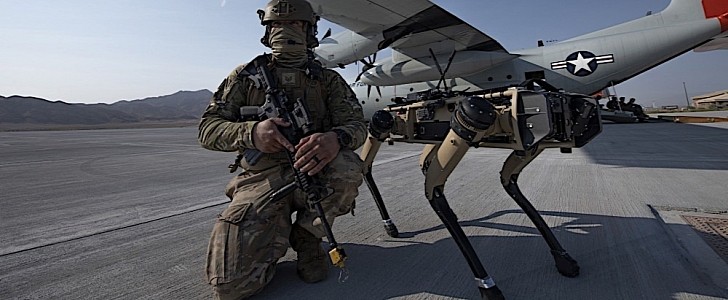There’s something very unsettling about seeing robot dogs disembarking from an Air Force C-130 airplane. It’s even more unsettling that military officials refer to these machines as dogs. Yet both these things happen, and in real life.
It’s no secret that the military is looking into robotic aides for whatever challenges the battlefields of tomorrow might pose. From the robot dogs we mentioned earlier to AI-powered drones accompanying fighter jets over enemy territory, there’s no shortage of developing technologies.
For a good number of these combined technologies, the military has a generic name: Advanced Battle Management System. As per the official description, ABMS as it’s called for short “allows a joint force to use cutting-edge methods and technologies to rapidly collect, analyze, and share information and make decisions in real time.”
Most of these methods and technologies were put to the test last week during a joint exercise at the Nellis Air Force Base in Nevada. Called “onramp”, the drill required soldiers to detect and defeat efforts to disrupt U.S. operations in space in addition to countering attacks against the U.S. homeland, including shooting down a cruise missile “surrogate” with a hypervelocity weapon.
Robot dogs were also involved. More precisely, Ghost Robotics’ Vision 60 metal canines came out of Air Force airplanes first, scanning for threats that could pose a danger to the humans that were soon to follow.
The Vision is not unlike another robot og you might be familiar with, Boston Dynamics’ Spot. Unlike the Spot though, we do not know much about the Vision in military guise because it is, you know, a secret.
“To win the contested, high-end fight, we need to accelerate how we field critical technologies today,” said in a statement Air Force Chief of Staff Gen. Charles Q. Brown, Jr.
“Rapid, iterative experimenting ultimately places relevant capability in warfighters’ hands faster. We cannot afford to slow our momentum on ABMS. Our warfighters and combatant commands must fight at internet speeds to win.”
For a good number of these combined technologies, the military has a generic name: Advanced Battle Management System. As per the official description, ABMS as it’s called for short “allows a joint force to use cutting-edge methods and technologies to rapidly collect, analyze, and share information and make decisions in real time.”
Most of these methods and technologies were put to the test last week during a joint exercise at the Nellis Air Force Base in Nevada. Called “onramp”, the drill required soldiers to detect and defeat efforts to disrupt U.S. operations in space in addition to countering attacks against the U.S. homeland, including shooting down a cruise missile “surrogate” with a hypervelocity weapon.
Robot dogs were also involved. More precisely, Ghost Robotics’ Vision 60 metal canines came out of Air Force airplanes first, scanning for threats that could pose a danger to the humans that were soon to follow.
The Vision is not unlike another robot og you might be familiar with, Boston Dynamics’ Spot. Unlike the Spot though, we do not know much about the Vision in military guise because it is, you know, a secret.
“To win the contested, high-end fight, we need to accelerate how we field critical technologies today,” said in a statement Air Force Chief of Staff Gen. Charles Q. Brown, Jr.
“Rapid, iterative experimenting ultimately places relevant capability in warfighters’ hands faster. We cannot afford to slow our momentum on ABMS. Our warfighters and combatant commands must fight at internet speeds to win.”




